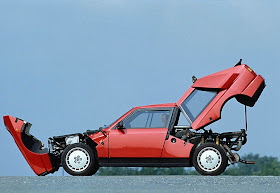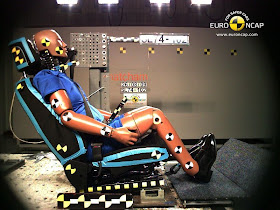
Citroen DS3 1.4 2009 EuroNCAP Crash Test
Frontal impact

Driver

Pole

CRS

Whiplash



Citroen DS3 2009 test results
Comments Adult occupantThe passenger compartment remained stable in the frontal impact. Dummy readings indicated good protection of the legs and femurs of both driver and pssenger. Citroen were able to demonstrate that similar protection would be offered to occupants of different sizes and to those sat in different seating positions. The car scored maximum points in the side barrier impact. In the more severe side pole test, chest protection was rated as weak, based on dummy readings of rib deflections. Protection against whiplash injuriy in a rear impact was rated as marginal.
Child occupantBoth dummies were sat in forward facing child restraints. In each case, forward movement of the head was not excessive in the frontal impact and, in the side impact, the dummies were both properly contained by the shells of their restraints. The passenger airbag can be disabled to allow a rearward facing restraint to be used in that seating position. However, information provided to the driver regarding the status of the airbag is not sufficiently clear. The label warning of the dangers of using a rearward facing child seat without first disabling the airbag is not available in all European languages and was not rewarded by Euro NCAP.
PedestrianIn most areas likely to be struck by the head of a pedestrian, the bonnet provided poor protection and scored no points. The bumper provided predominantly good protection for pedestrians' legs.
Safety assistAll variants of the DS3 are equipped as standard with electronic stability control, a seatbelt reminder for the driver and front passenger seats and a driver-set speed limitation device
Photos, Comments: EuroNCAP
 Lancia Delta S4 1985 - 1988
Lancia Delta S4 1985 - 1988

 Lancia Delta S4 1985 - 1988
Lancia Delta S4 1985 - 1988 Lancia Delta S4 Group B 1985
Lancia Delta S4 Group B 1985

 Lancia Delta S4 Group B 1985
Lancia Delta S4 Group B 1985 Citroen DS3 1.4 2009 EuroNCAP Crash Test
Citroen DS3 1.4 2009 EuroNCAP Crash Test Driver
Driver Pole
Pole CRS
CRS Whiplash
Whiplash

 Citroen DS3 2009 test results
Citroen DS3 2009 test results Saab 9-5 2.0 diesel Linear 2009 EuroNCAP Crash Test
Saab 9-5 2.0 diesel Linear 2009 EuroNCAP Crash Test Driver
Driver Pole
Pole CRS
CRS Whiplash
Whiplash

 Saab 9-5 2009 test results
Saab 9-5 2009 test results